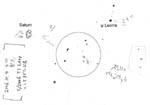Wednesday October 4, 2006
However, the comet turned out to be C/2006
T1 Levy, which was announced on IAUC 3 hours and 43 minutes before my
discovery.
How sever it is!
I went to bed before 10 pm yesterday and got up at 2 am this predawn. I drove 20 minutes and arrived at usual observing site. I wanted to sweep Leo today. One reason is that I conducted comet hunting six times in these two weeks but I did not sweep Leo. Another is that Tsutomu Sekifs publications said that many comets were found at the constellation of Leo in October. Unexpectedly, it was foggy at the low altitude of the sky (less than 20 or 30 degrees) but I began to comet hunt from the head of Leo at 3:00 am. After 10 minutes eastern sky became very misty and I was forced to search the south where the sky was clear: I caught NGC2207 (Galaxy) in the south. At 3:40 am whole the sky got clear and I trained my telescope on Leo region again.
I swept the sky vertically and after the Saturn
has passed the field twice (the field was overlapped 1/3), a bright
comet like
object came in the center of the field. I guessed it must be NGC2903. I
tried
to identify this object using the digital setting circles: it said the
object
was NGC3020 that is more than 2 degrees away from the comet like
object. At
this moment I concluded that this object is a new comet, because I knew
there
is no such bright object around this area except NGC2903!

 Scketch
2
Scketch
2 Click to enlarge
I checked the
position referring to the
indicator of the digital setting circles and the Uranometria 2000. I
thought that any observers in
I checked the position again and tried to confirm the motion, drew a rough sketch, and estimated brightness and a diameter. It moved eastward roughly 1f per 30 minutes. It disappeared in the twilight at 4:46am. At 4:53am I phoned the National Astronomical Observatory of Japan and left a message about the comet. I knew the staff would come to the office at 9am and would contact me later.
I disassembled the telescope and got home. I confirmed there is no known comet at the position using MegaSatar ver.5. Then, I checked the e-mail.
Hirohisa Sato, via OAA-comet mailing list (in Japanese), said the following object was listed on NEO CP:
J01E42 [2006 Oct. 02.5 UT. R.A. = 09 41.4,
Decl. = +15 19, V = 12.5] Added Oct. 2.83 UT [1 nighter]
Observer Comments:
Receipt time COD INIT ONS Comment
2006 10 3.1992 J95 PB yes Found 3' W and 2' S
of
nominal
I do not know the
detail of this page but
the object has been known in the public!
How
disappointing!
After that Katsumi Yoshimoto reported visual observation of this comet with Comet–obs mailing list (in Japanese) at 6:49 am.
C/2006
T1 (Levy)
IIIYYYYMnL YYYY MM DD.DD eM/mm.m:r AAA.ATF/xxxx /dd.ddnDC /t.ttmANG ICQ
XX*OBSxx
2006T1 2006 10 03.81 xM 9.8 TK 25.4L 4
46 3.4
3 ICQ
XX
YOS02
This is not official discovery but I reported my ediscoveryf to Syuichi Nakano, CBAT, and the National Astronomical Observatory of Japan. In this evening Nakano e-mailed me and said he was observing the comet when I made a phone call.
In
the Internet era, competition becomes
much more serious.
Even though there are still chances to
discover comets as I did this predawn!
*******************
My discovery memo:
The equinox: 2000.
R.A. 09h42m40s@
Decl. +15deg 02f
Total magnitude: 9.5
Diameter:5 f
Degree of central condensation: 6 (0 is completely diffuse and 9 is
completelystellar in appearance) Motion:1f? , Direction East, for
30minutes
Observed time: 3.79236UT, Oct, 2006
Telescope: 18 inch (45.7 cm), reflector, 68x (visual discovery)